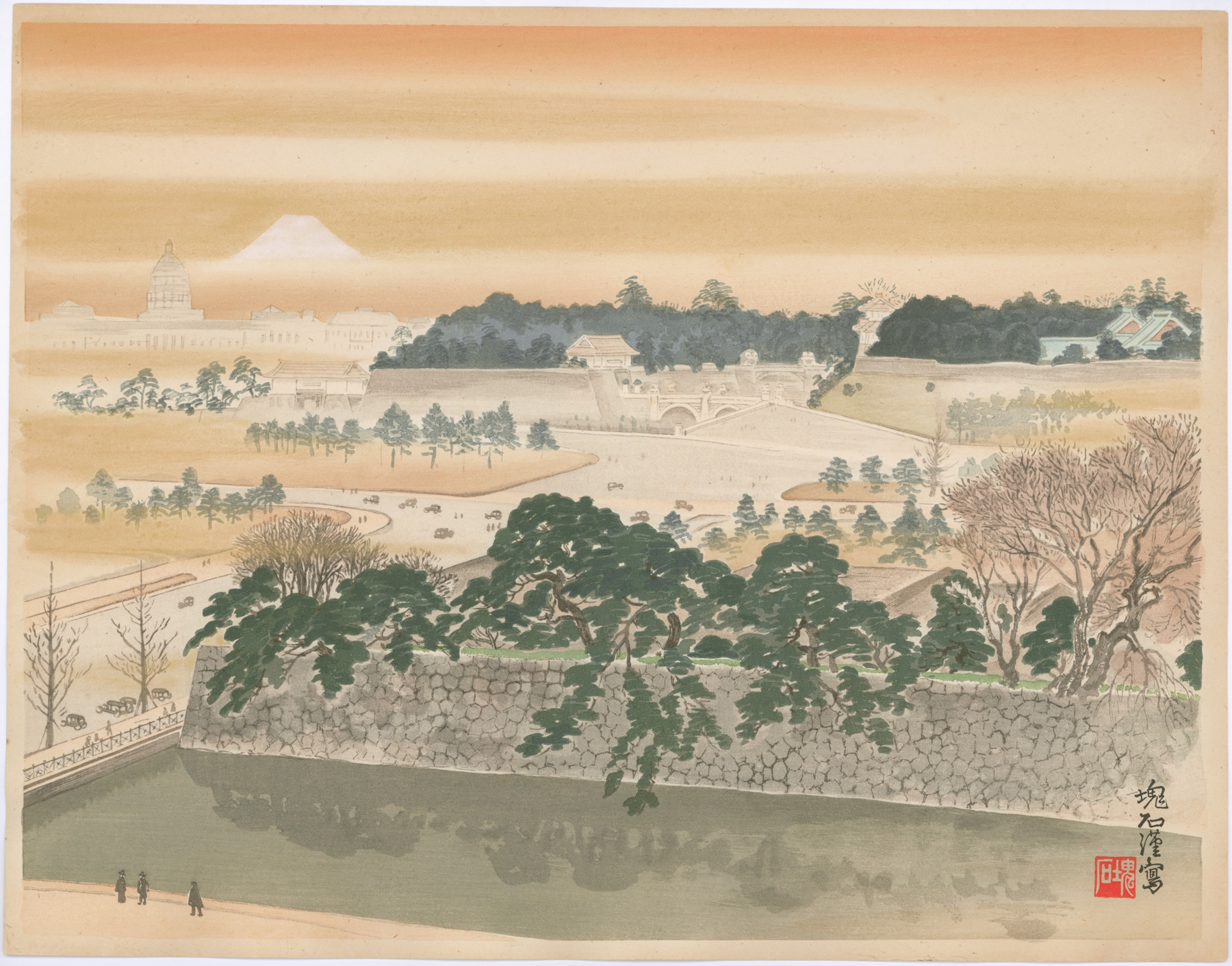About This Print
One of twenty-five prints in the series Twenty-Five Views of Mount Fuji: A Woodblock Collection, published by the artist in 1931. In this print we see the Imperial Palace grounds in the foreground (with the palace's outer moat in the immediate foreground), the National Diet Building, which would have been under construction at the time, behind the palace grounds on the left and a very white Mount Fuji standing as a beacon in the background. Cars and people dot the scene and hazy clouds, reddened by the setting sun, streak the sky.About This Series
As mentioned in the artist's biography, there is some confusion about whether Jōkata created one or two series of prints with views of Mt. Fuji. While a number of sources refer to a ca. 1929 twelve print series of views of Fuji, the only documentation I've seen is for the 1931 twenty-five print series, which includes all twelve prints supposedly making up the 1929 series. While the author quoted below references the twelve print 1929 series, the words equally apply to the 1931 series.
In the 1920s and 1930s the constituent parts of old and new Japan often collided. As with writers of the period, print artists frequently focused on this friction between the past and present. Jōkata Kaiseki's twelve print series Views of Fuji from 1929 ... sights a symbol of traditional Japan through the lens of modernity. [A]irplanes and power poles are placed alongside such traditional emblems as farmhouses and rural villages. Kaiseki, an artist known only through this series, was likely familiar with the ukiyo-e tradition. By "hiding" Mt. Fuji in his compositions, he alludes to Hokusai's classic Thirty-Six Views of Mt. Fuji (Fuji sanjūrokkei) of 1828-1833 in which Mt. Fuji is sometimes viewed through a barrel or from under an arched wooden bridge. Kaiseki's Mt. Fuji, a symbol of traditional Japan, exists in a world which contains modern elements.1
For more information on the series see the section titled "The Kaiseki Mount Fuji Prints" on the artist's bio page Jōkata Kaiseki (1882-1966).
1 "The Cultural Landscape: Modernity and its Ideological Reaction," by Alexandra J. Marmion appearing in Light in Darkness: Women in Japanese Prints of Early Shōwa (1926-1945), Kendall H. Brown, et. al., Fisher Gallery, University of Southern California, 1996, p. 21.
Print Details
| IHL Catalog | #1893 |
| Title | Imperial Palace and Mount Fuji 宮城と富士 [title as given in the table of contents accompanying the entire series] Alternate Title: 皇居からの富士 |
| Series | Twenty-Five Views of Mount Fuji: Woodblock Collection 木版画集 富士二十五景 |
| Artist | Jōkata Kaiseki (1882-1966) |
| Signature |  |
| Seal | sealed 塊石 Kaiseki [see image above] |
| Publication Date | 1931 |
| Edition | |
| Publisher | self-published under the name Kaiseki Print Publishing Society 塊石版画刊行会 |
| Printer | unknown |
| Carver | Kawatsura Yoshio (1880-1963) |
| Impression | excellent |
| Colors | excellent |
| Condition | excellent |
| Genre | sosaku-hanga (creative print) |
| Miscellaneous | |
| Format | dai-ōban |
| H x W Paper | 11 1/8 x 14 3/8 in. (28.6 x 36.5 cm) |
| H x W Image | 10 1/8 x 13 7/8 in. (25.7 x 35.2 cm) |
| Collections This Print | |
| Reference Literature |
12/23/2018


